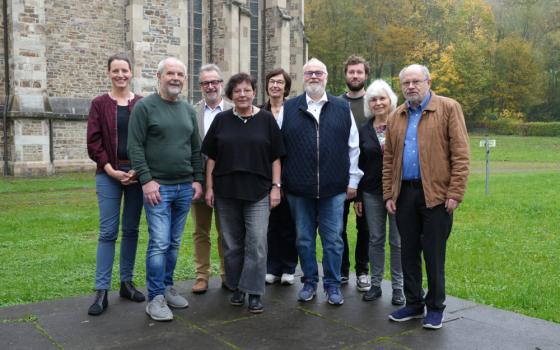
A young girl is dressed as Our Lady of Guadalupe outside Our Lady of Guadalupe Catholic Church in Houston Dec. 12, 2019. (CNS/Texas Catholic Herald/James Ramos)
Today, the Third Sunday of Advent, is also the feast of Our Lady of Guadalupe. How appropriate to celebrate this fiesta of love and liberation while the church throughout the world is invited to rejoice in the new things God is doing among us!
"La Morenita," as Guadalupe is called affectionately, is the patron of the Americas and undoubtedly our hemisphere's most beloved manifestation of Mary, the mother of God. The designation, morenita, refers to the fact that the image of Guadalupe depicts Mary as a mestiza, a person of both European and American ancestry, a divinely fashioned mixture of cultures.
For those who don't know the details, in 1531, St. Juan Diego Cuauhtlatotzin, an indigenous peasant, received four apparitions/visits from the woman he eventually identified as the Virgin Mary. She commissioned him to tell his bishop to build a shrine in her honor on a hill that had been a place to honor the Aztec mother-goddess, Tonantzin.
The dialogue between Mary and Juan Diego is full of mutual endearments. She calls him "the littlest of my sons," and he responds by calling her, "my Lady, Queen, my little one." As the story goes, after ineffective attempts to explain the apparition to the bishop, Mary directed Juan Diego to collect roses from the sacred hill. When he went back to the bishop and opened his tilma (cloak), roses poured out and revealed the image of the Virgin who had been conversing with Juan Diego.
Even more than Mary's verbal message, her image as Our Lady of Guadalupe conveyed a message of good news that echoes each of today's readings.
Among the most important dimensions of the image are Mary's eyes, her dress and the natural symbols around her. Mary's eyes, which some claim show a reflection of Juan Diego, are cast down, a sign for the Aztecs that she was not a god. At the same time, she is dressed in a turquoise mantle, representing the highest of the Aztec gods. To resolve that tension, there is a maternity band around her waist, indicating that she is the bearer of one to come.
The stars that adorn her cloak signify the coming of a new age. The sunrays emanating from behind her symbolize the fact that she is greater than the sun itself.
Advertisement
Altogether, the image offers a message to the people undergoing conquest as well as to the invaders who were supposed to evangelize them.
La Morenita brought Juan Diego and his people the same message we hear in today's readings. The prophet Zephaniah said, "Shout for joy … The LORD, your God is in your midst." La Morenita told Juan Diego, "I will give the peoples my love, my compassion, my help."
In today's Gospel, John the Baptist called individuals, each in their own way, to act with justice. La Morenita, speaking as much like God to Moses as like the Baptizer, told Juan Diego, "I will listen to your cries and sadness ... relieve and heal your pain, your misery, your hurts." That's God's message of liberation.
Our Lady of Guadalupe appeared just over a decade after the Spanish conquest of Mexico. In a time marked by turmoil, abuse and prophecy, she epitomized the potential of the Gospel to bring ancient traditions together to create something that neither could imagine until they allowed grace to lead them into it. She embodied an American expression of John the Baptist's voice crying in the wilderness.
Our Lady of Guadalupe symbolizes divine love and God's desire that humanity create a community of love and justice.
The celebration of the feast of Our Lady of Guadalupe on the Third Sunday of Advent creates a unique invitation for our own time. Our turmoil includes a pandemic and its attendant economic and social disruptions, increasing numbers of people on the move seeking a way to survive, and the church's 2022 road toward creating a religious culture of synodality that can teach us to appreciate the diverse experience and insights of all who are called together by Christ.
Our Lady of Guadalupe symbolizes divine love and God's desire that humanity create a community of love and justice. La Morenita incarnates the intercultural unity that is possible when we allow faith to lead us to a communion that respects and simultaneously goes deeper than our diversity.
This feast day offers us individual and communal invitations to conversion. On the personal level, Zephaniah and Our Lady of Guadalupe invite us to hear the message of God's indomitable love and presence among us.
On a communal level, Mary's reiteration of God's attention to the suffering of the poor and oppressed pleads with us to heed John's instructions. John called for social reform, telling tax collectors and soldiers to begin to act with justice. Our task now is to apply his style of reform to our own professions and social structures.






